
Timeline of discovery of solar system planets and their natural satellites
Encyclopedia
The timeline of discovery of Solar System planets and their natural satellites charts the progress of the discovery of new bodies over history. Each object is listed in chronological order of its discovery (multiple dates occur when the moments of imaging, observation, and publication differ), identified through its various designations (including temporary and permanent schemes), and the discoverer(s) listed.
Historically the naming of moons did not always match the times of their discovery. Traditionally, the discoverer enjoys the privilege of naming the new object; however, some neglected to do so (E. E. Barnard stated he would "defer any suggestions as to a name [for Amalthea] until a later paper" but never got around to picking one from the numerous suggestions he received) or actively declined (S. B. Nicholson
Seth Barnes Nicholson
Seth Barnes Nicholson was an American astronomer.Nicholson was born in Springfield, Illinois and was raised in rural Illinois...
stated "Many have asked what the new satellites [(Lysithea and Carme)] are to be named. They will be known only by the numbers X and XI, written in Roman numerals, and usually prefixed by the letter J to identify them with Jupiter."). The issue arose nearly as soon as planetary satellites were discovered: Galileo referred to the four main satellites of Jupiter
Galilean moons
The Galilean moons are the four moons of Jupiter discovered by Galileo Galilei in January 1610. They are the largest of the many moons of Jupiter and derive their names from the lovers of Zeus: Io, Europa, Ganymede and Callisto. Ganymede, Europa and Io participate in a 1:2:4 orbital resonance...
using numbers while the names suggested by his rival Simon Marius
Simon Marius
Simon Marius was a German astronomer. He was born in Gunzenhausen, near Nuremberg, but he spent most of his life in the city of Ansbach....
gradually gained universal acceptance. The International Astronomical Union
International Astronomical Union
The International Astronomical Union IAU is a collection of professional astronomers, at the Ph.D. level and beyond, active in professional research and education in astronomy...
(IAU) eventually started cleaning up the naming business in the late 1970s.
Key
In the following tables, planetary satellites are indicated in bold type (e.g. Moon) while planets and dwarf planets, which directly circle the Sun are in italic type (e.g. Earth). The tables are sorted by publication/announcement date. Dates are annotated with the following symbols:- i: for date of first imaging (photography, etc.);
- o: for date of first human visual observation, either through telescope or on photographic plate (the true discovery moment);
- p: for date of announcement or publication.
In a few cases, the date is uncertain and is then marked "(?)".
* Note: Moons marked by an asterisk (*) had complicated discoveries. Some took years to be confirmed, and in several cases were actually lost and rediscovered. Others were found in Voyager
Voyager program
The Voyager program is a U.S program that launched two unmanned space missions, scientific probes Voyager 1 and Voyager 2. They were launched in 1977 to take advantage of a favorable planetary alignment of the late 1970s...
photographs years after they were taken.
Color legend
The planets and their natural satellites are marked in the following colors:
Planets
Dwarf planets
Designations
- Other designations are synonyms or periphrases sometimes encountered for the object.
- Permanent designations (of planetary satellites) are explained here.
- Temporary designations are explained here.
Prehistory
| Prehistory Prehistory Prehistory is the span of time before recorded history. Prehistory can refer to the period of human existence before the availability of those written records with which recorded history begins. More broadly, it refers to all the time preceding human existence and the invention of writing... |
||||
|---|---|---|---|---|
| Name | Image | Other designation | Notes | |
| Sun Sun The Sun is the star at the center of the Solar System. It is almost perfectly spherical and consists of hot plasma interwoven with magnetic fields... |
Star | In Ptolemy Ptolemy Claudius Ptolemy , was a Roman citizen of Egypt who wrote in Greek. He was a mathematician, astronomer, geographer, astrologer, and poet of a single epigram in the Greek Anthology. He lived in Egypt under Roman rule, and is believed to have been born in the town of Ptolemais Hermiou in the... 's geocentric model Geocentric model In astronomy, the geocentric model , is the superseded theory that the Earth is the center of the universe, and that all other objects orbit around it. This geocentric model served as the predominant cosmological system in many ancient civilizations such as ancient Greece... , the Earth was believed to be at the center of the cosmos. Seven planets were placed in orbit around it in an order of increasing distance from the Earth, as established by the Greek Stoics Stoicism Stoicism is a school of Hellenistic philosophy founded in Athens by Zeno of Citium in the early . The Stoics taught that destructive emotions resulted from errors in judgment, and that a sage, or person of "moral and intellectual perfection," would not suffer such emotions.Stoics were concerned... : the Moon, Mercury, Venus, the Sun, Mars, Jupiter and Saturn. This list included two objects, the Sun and the Moon, which are no longer considered to be planets; it also excluded the Earth. |
||
| Moon Moon The Moon is Earth's only known natural satellite,There are a number of near-Earth asteroids including 3753 Cruithne that are co-orbital with Earth: their orbits bring them close to Earth for periods of time but then alter in the long term . These are quasi-satellites and not true moons. For more... |
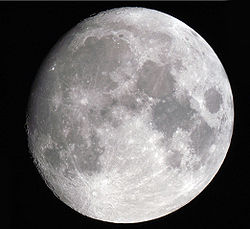 |
Earth I | In the Copernican system, the Moon was considered to be no longer a planet but a natural satellite Natural satellite A natural satellite or moon is a celestial body that orbits a planet or smaller body, which is called its primary. The two terms are used synonymously for non-artificial satellites of planets, of dwarf planets, and of minor planets.... of the Earth, and was the only body in that system whose revolution was not centered on the Sun. |
|
| Mercury Mercury (planet) Mercury is the innermost and smallest planet in the Solar System, orbiting the Sun once every 87.969 Earth days. The orbit of Mercury has the highest eccentricity of all the Solar System planets, and it has the smallest axial tilt. It completes three rotations about its axis for every two orbits... |
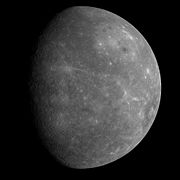 |
1st Planet | The inner planets, Mercury and Venus, and the outer planets, Mars, Jupiter and Saturn, were identified by ancient Babylonian astronomers in the 2nd millennium BC. By Aristarchus of Samos Aristarchus of Samos Aristarchus, or more correctly Aristarchos , was a Greek astronomer and mathematician, born on the island of Samos, in Greece. He presented the first known heliocentric model of the solar system, placing the Sun, not the Earth, at the center of the known universe... , and later in Nicolaus Copernicus Nicolaus Copernicus Nicolaus Copernicus was a Renaissance astronomer and the first person to formulate a comprehensive heliocentric cosmology which displaced the Earth from the center of the universe.... ' heliocentric system Heliocentrism Heliocentrism, or heliocentricism, is the astronomical model in which the Earth and planets revolve around a stationary Sun at the center of the universe. The word comes from the Greek . Historically, heliocentrism was opposed to geocentrism, which placed the Earth at the center... (De Revolutionibus Orbium Coelestium De revolutionibus orbium coelestium De revolutionibus orbium coelestium is the seminal work on the heliocentric theory of the Renaissance astronomer Nicolaus Copernicus... , 1543) the Earth came to be considered a planet revolving with the other planets around the Sun, in the following order of distance from the Sun: Mercury, Venus, Earth, Mars, Jupiter, and Saturn. The Sun, now situated near the center of revolution, was no longer considered a planet. |
|
| Venus Venus Venus is the second planet from the Sun, orbiting it every 224.7 Earth days. The planet is named after Venus, the Roman goddess of love and beauty. After the Moon, it is the brightest natural object in the night sky, reaching an apparent magnitude of −4.6, bright enough to cast shadows... |
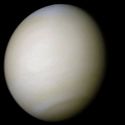 |
2nd Planet | ||
| Earth Earth Earth is the third planet from the Sun, and the densest and fifth-largest of the eight planets in the Solar System. It is also the largest of the Solar System's four terrestrial planets... |
 |
3rd Planet | ||
| Mars Mars Mars is the fourth planet from the Sun in the Solar System. The planet is named after the Roman god of war, Mars. It is often described as the "Red Planet", as the iron oxide prevalent on its surface gives it a reddish appearance... |
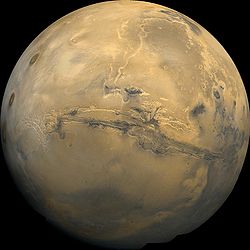 |
4th Planet |
||
|-
| bgcolor="#FFE8E8" | Jupiter
Jupiter
Jupiter is the fifth planet from the Sun and the largest planet within the Solar System. It is a gas giant with mass one-thousandth that of the Sun but is two and a half times the mass of all the other planets in our Solar System combined. Jupiter is classified as a gas giant along with Saturn,...
| bgcolor="Black" |

|-
| bgcolor="#FFFFCC" | Saturn
Saturn
Saturn is the sixth planet from the Sun and the second largest planet in the Solar System, after Jupiter. Saturn is named after the Roman god Saturn, equated to the Greek Cronus , the Babylonian Ninurta and the Hindu Shani. Saturn's astronomical symbol represents the Roman god's sickle.Saturn,...
| bgcolor="Black" |
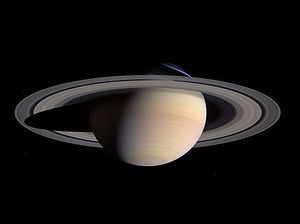
|}
17th century
| 17th century | ||||
|---|---|---|---|---|
| Date | Name | Image | Permanent designation | Discoverer(s) and notes |
| 1610s | ||||
| o: January 7, 1610 p: March 13, 1610 |
Ganymede Ganymede (moon) Ganymede is a satellite of Jupiter and the largest moon in the Solar System. It is the seventh moon and third Galilean satellite outward from Jupiter. Completing an orbit in roughly seven days, Ganymede participates in a 1:2:4 orbital resonance with the moons Europa and Io, respectively... |
Jupiter III | Galileo Galileo Galilei Galileo Galilei , was an Italian physicist, mathematician, astronomer, and philosopher who played a major role in the Scientific Revolution. His achievements include improvements to the telescope and consequent astronomical observations and support for Copernicanism... . The Galilean moons Galilean moons The Galilean moons are the four moons of Jupiter discovered by Galileo Galilei in January 1610. They are the largest of the many moons of Jupiter and derive their names from the lovers of Zeus: Io, Europa, Ganymede and Callisto. Ganymede, Europa and Io participate in a 1:2:4 orbital resonance... . The Galilean satellites were the first celestial objects that were confirmed to orbit an object other than the Sun or Earth. Galileo saw Io and Europa as a single point of light on January 7, 1610; they were seen as separate bodies the following night. |
|
| Callisto Callisto (moon) Callisto named after the Greek mythological figure of Callisto) is a moon of the planet Jupiter. It was discovered in 1610 by Galileo Galilei. It is the third-largest moon in the Solar System and the second largest in the Jovian system, after Ganymede. Callisto has about 99% the diameter of the... |
 |
Jupiter IV | ||
| o: January 8, 1610 p: March 13, 1610 |
Io Io (moon) Io ) is the innermost of the four Galilean moons of the planet Jupiter and, with a diameter of , the fourth-largest moon in the Solar System. It was named after the mythological character of Io, a priestess of Hera who became one of the lovers of Zeus.... |
 |
Jupiter I | |
| Europa Europa (moon) Europa Slightly smaller than Earth's Moon, Europa is primarily made of silicate rock and probably has an iron core. It has a tenuous atmosphere composed primarily of oxygen. Its surface is composed of ice and is one of the smoothest in the Solar System. This surface is striated by cracks and... |
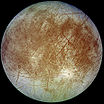 |
Jupiter II | ||
| 1650s | ||||
| o: March 25, 1655 p: March 5, 1656 |
Titan Titan (moon) Titan , or Saturn VI, is the largest moon of Saturn, the only natural satellite known to have a dense atmosphere, and the only object other than Earth for which clear evidence of stable bodies of surface liquid has been found.... |
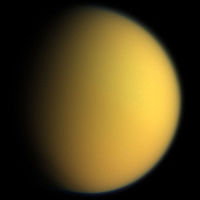 |
Saturn VI , |
Huygens. He first "published" his discovery as an anagram Anagram An anagram is a type of word play, the result of rearranging the letters of a word or phrase to produce a new word or phrase, using all the original letters exactly once; e.g., orchestra = carthorse, A decimal point = I'm a dot in place, Tom Marvolo Riddle = I am Lord Voldemort. Someone who... , sent out on 13 June 1655; later published in pamphlet form as De Saturni luna Observatio Nova and in full in Systema Saturnium (July 1659). |
| 1670s | ||||
| o: October 25, 1671 p: 1673 |
Iapetus Iapetus (moon) Iapetus ), occasionally Japetus , is the third-largest moon of Saturn, and eleventh in the Solar System. It was discovered by Giovanni Domenico Cassini in 1671... |
 |
Saturn VIII , , |
Cassini Giovanni Domenico Cassini This article is about the Italian-born astronomer. For his French-born great-grandson, see Jean-Dominique Cassini.Giovanni Domenico Cassini was an Italian/French mathematician, astronomer, engineer, and astrologer... |
| o: December 23, 1672 p: 1673 |
Rhea Rhea (moon) Rhea is the second-largest moon of Saturn and the ninth largest moon in the Solar System. It was discovered in 1672 by Giovanni Domenico Cassini.-Name:Rhea is named after the Titan Rhea of Greek mythology, "mother of the gods"... |
_thumb.jpg) |
Saturn V , |
|
| 1680s | ||||
| o: March 21, 1684 p: April 22, 1686 |
Tethys Tethys (moon) Tethys or Saturn III is a mid-sized moon of Saturn about across. It was discovered by G. D. Cassini in 1684 and is named after titan Tethys of Greek mythology. Tethys is pronounced |Odysseus]] is about 400 km in diameter, while the largest graben—Ithaca Chasma is about 100 km wide and... |
 |
Saturn III |
Cassini. Together with his previous two discoveries, Cassini named these satellites Sidera Lodoicea Sidera Lodoicea Sidera Lodoicea is the name given by the astronomer Giovanni Domenico Cassini to the four moons of Saturn discovered by him in the years 1671, 1672, and 1684 and published in his Découverte de deux nouvelles planètes autour de Saturne in 1673 and in the Journal des sçavans in 1686... . In his work Kosmotheôros (published posthumously in 1698), Christiaan Huygens relates "Jupiter you see has his four, and Saturn his five Moons about him, all plac’d in their Orbits." |
| Dione Dione (moon) Dione is a moon of Saturn discovered by Cassini in 1684. It is named after the titan Dione of Greek mythology. It is also designated Saturn IV.- Name :... |
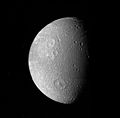 |
Saturn IV |
||
| Date | Name | Image | Permanent designation | Discoverer(s) and notes |
18th century
| 18th century | ||||
|---|---|---|---|---|
| Date | Name | Image | Other/Permanent designation | Discoverer(s) and notes |
| 1780s | ||||
| o: March 13, 1781 |
Uranus Uranus Uranus is the seventh planet from the Sun. It has the third-largest planetary radius and fourth-largest planetary mass in the Solar System. It is named after the ancient Greek deity of the sky Uranus , the father of Cronus and grandfather of Zeus... |
 |
7th Planet | Herschel William Herschel Sir Frederick William Herschel, KH, FRS, German: Friedrich Wilhelm Herschel was a German-born British astronomer, technical expert, and composer. Born in Hanover, Wilhelm first followed his father into the Military Band of Hanover, but emigrated to Britain at age 19... first reported the discovery of Uranus on April 26, 1781, initially believing it a comet Comet A comet is an icy small Solar System body that, when close enough to the Sun, displays a visible coma and sometimes also a tail. These phenomena are both due to the effects of solar radiation and the solar wind upon the nucleus of the comet... . |
| o: January 11, 1787 |
Titania Titania (moon) Titania is the largest of the moons of Uranus and the eighth largest moon in the Solar System at a diameter of 1578 km. Discovered by William Herschel in 1787, Titania is named after the queen of the fairies in Shakespeare's A Midsummer Night's Dream... |
_color_cropped.jpg) |
Uranus III | Herschel. He later reported four more spurious satellites. |
| Oberon Oberon (moon) Oberon , also designated ', is the outermost major moon of the planet Uranus. It is the second largest and second most massive of the Uranian moons, and the ninth most massive moon in the Solar System. Discovered by William Herschel in 1787, Oberon is named after the mythical king of the fairies... |
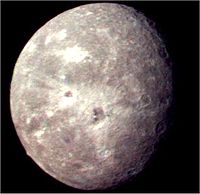 |
Uranus IV | ||
| o: August 28, 1789 |
Enceladus Enceladus (moon) Enceladus is the sixth-largest of the moons of Saturn. It was discovered in 1789 by William Herschel. Until the two Voyager spacecraft passed near it in the early 1980s very little was known about this small moon besides the identification of water ice on its surface... |
 |
Saturn II | Herschel |
| o: September 17, 1789 |
Mimas Mimas (moon) Mimas is a moon of Saturn which was discovered in 1789 by William Herschel. It is named after Mimas, a son of Gaia in Greek mythology, and is also designated Saturn I.... |
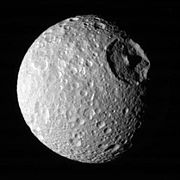 |
Saturn I | |
| Date | Name | Image | Other/Permanent designation | Discoverer(s) and notes |
19th century
| 19th century | ||||
|---|---|---|---|---|
| Date | Name | Image | Other/Permanent designation | Discoverer(s) and notes |
| 1800s | ||||
| o: January 1, 1801 |
Ceres | 8th Planet Planet A planet is a celestial body orbiting a star or stellar remnant that is massive enough to be rounded by its own gravity, is not massive enough to cause thermonuclear fusion, and has cleared its neighbouring region of planetesimals.The term planet is ancient, with ties to history, science,... (1801) Asteroid Asteroids are a class of small Solar System bodies in orbit around the Sun. They have also been called planetoids, especially the larger ones... (1851) Dwarf planet A dwarf planet, as defined by the International Astronomical Union , is a celestial body orbiting the Sun that is massive enough to be spherical as a result of its own gravity but has not cleared its neighboring region of planetesimals and is not a satellite... (2006) |
Giuseppe Piazzi Giuseppe Piazzi Giuseppe Piazzi was an Italian Catholic priest of the Theatine order, mathematician, and astronomer. He was born in Ponte in Valtellina, and died in Naples. He established an observatory at Palermo, now the Osservatorio Astronomico di Palermo – Giuseppe S... . He first announced his discovery on January 24, 1801, in letters to fellow astronomers. The first formal publication was the September 1801 issue of the Monatliche Correspondenz. |
|
| 1840s | ||||
| o: September 23, 1846 |
Neptune Neptune Neptune is the eighth and farthest planet from the Sun in the Solar System. Named for the Roman god of the sea, it is the fourth-largest planet by diameter and the third largest by mass. Neptune is 17 times the mass of Earth and is slightly more massive than its near-twin Uranus, which is 15 times... |
 |
13th Planet (1846) |
Galle Johann Gottfried Galle Johann Gottfried Galle was a German astronomer at the Berlin Observatory who, on 23 September 1846, with the assistance of student Heinrich Louis d'Arrest, was the first person to view the planet Neptune, and know what he was looking at... and Le Verrier |
| o: October 10, 1846 |
Triton Triton (moon) Triton is the largest moon of the planet Neptune, discovered on October 10, 1846, by English astronomer William Lassell. It is the only large moon in the Solar System with a retrograde orbit, which is an orbit in the opposite direction to its planet's rotation. At 2,700 km in diameter, it is... |
.jpg) |
Neptune I | Lassell William Lassell William Lassell FRS was an English merchant and astronomer.Born in Bolton and educated in Rochdale after the death of his father, he was apprenticed from 1814 to 1821 to a merchant in Liverpool. He then made his fortune as a beer brewer, which enabled him to indulge his interest in astronomy... |
| o: September 16, 1848 |
Hyperion Hyperion (moon) Hyperion , also known as Saturn VII, is a moon of Saturn discovered by William Cranch Bond, George Phillips Bond and William Lassell in 1848. It is distinguished by its irregular shape, its chaotic rotation, and its unexplained sponge-like appearance... |
 |
Saturn VII | Bond William Cranch Bond William Cranch Bond was an American astronomer, and the first director of Harvard College Observatory.- Upbringing :William Cranch Bond was born in Falmouth, Maine on September 9, 1789... , Bond George Phillips Bond George Phillips Bond was an American astronomer. He was the son of William Cranch Bond. Some sources give his year of birth as 1826.... , Lassell William Lassell William Lassell FRS was an English merchant and astronomer.Born in Bolton and educated in Rochdale after the death of his father, he was apprenticed from 1814 to 1821 to a merchant in Liverpool. He then made his fortune as a beer brewer, which enabled him to indulge his interest in astronomy... |
| 1850s | ||||
| o: October 24, 1851 | Ariel Ariel (moon) Ariel is the brightest and fourth-largest of the 27 known moons of Uranus. Ariel orbits and rotates in the equatorial plane of Uranus, which is almost perpendicular to the orbit of Uranus, and so has an extreme seasonal cycle.... |
.jpg) |
Uranus I | Lassell William Lassell William Lassell FRS was an English merchant and astronomer.Born in Bolton and educated in Rochdale after the death of his father, he was apprenticed from 1814 to 1821 to a merchant in Liverpool. He then made his fortune as a beer brewer, which enabled him to indulge his interest in astronomy... |
| Umbriel Umbriel (moon) Umbriel is a moon of Uranus discovered on October 24, 1851, by William Lassell. It was discovered at the same time as Ariel and named after a character in Alexander Pope's poem The Rape of the Lock. Umbriel consists mainly of ice with a substantial fraction of rock, and may be differentiated into a... |
.jpg) |
Uranus II | ||
| 1870s | ||||
| o: August 12, 1877 | Deimos Deimos (moon) Deimos is the smaller and outer of Mars's two moons . It is named after Deimos, a figure representing dread in Greek Mythology. Its systematic designation is '.-Discovery:Deimos was discovered by Asaph Hall, Sr... |
 |
Mars II | Hall Asaph Hall Asaph Hall III was an American astronomer who is most famous for having discovered the moons of Mars in 1877... |
| o: August 18, 1877 | Phobos Phobos (moon) Phobos is the larger and closer of the two natural satellites of Mars. Both moons were discovered in 1877. With a mean radius of , Phobos is 7.24 times as massive as Deimos... |
.jpg) |
Mars I | |
| 1890s | ||||
| o: September 9, 1892 |
Amalthea Amalthea (moon) Amalthea is the third moon of Jupiter in order of distance from the planet. It was discovered on September 9, 1892, by Edward Emerson Barnard and named after Amalthea, a nymph in Greek mythology. It is also known as '.... |
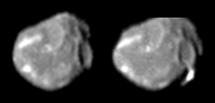 |
Jupiter V | Barnard |
| i: August 16, 1898 |
Phoebe Phoebe (moon) Phoebe is an irregular satellite of Saturn. It was discovered by William Henry Pickering on 17 March 1899 from photographic plates that had been taken starting on 16 August 1898 at the Boyden Observatory near Arequipa, Peru, by DeLisle Stewart... |
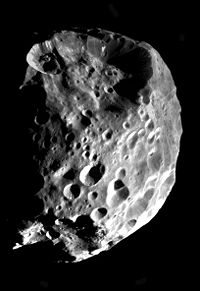 |
Saturn IX | Pickering William Henry Pickering William Henry Pickering was an American astronomer, brother of Edward Charles Pickering. He was elected a Fellow of the American Academy of Arts and Sciences in 1883.-Work:... |
| Date | Name | Image | Other/Permanent designation | Discoverer(s) and notes |
Early 20th century (1901–1950)
| Early 20th century | ||||
|---|---|---|---|---|
| Date | Name | Image | Permanent designation | Discoverer(s) and notes |
| 1900s | ||||
| i: December 3, 1904 |
Himalia Himalia (moon) Himalia is the largest irregular satellite of Jupiter, the sixth largest overall in size, and the fifth largest in mass. It was discovered by Charles Dillon Perrine at the Lick Observatory on 3 December 1904 and is named after the nymph Himalia, who bore three sons of Zeus .- Discovery... |
Jupiter VI | Perrine Charles Dillon Perrine Charles Dillon Perrine was an American astronomer living in Argentina.Born in Steubenville, Ohio, a son of Peter and Elizabeth McCauley Perrine, and a descendant of Daniel Perrin, "The Huguenot", he worked at Lick Observatory from 1893 to 1909 and then was director of the Argentine National... |
|
| i: January 2, 1905 |
Elara Elara (moon) Elara is a prograde irregular satellite of Jupiter. It was discovered by Charles Dillon Perrine at Lick Observatory in 1905. It is the eighth largest moon of Jupiter and is named after the mother by Zeus of the giant Tityus.... |
Jupiter VII | Perrine | |
| i: January 27, 1908 |
Pasiphaë Pasiphaë (moon) Pasiphaë is a retrograde irregular satellite of Jupiter. It was discovered in 1908 by Philibert Jacques Melotte and later named after the mythological Pasiphaë, wife of Minos and mother of the Minotaur from Greek legend.... |
Jupiter VIII | Melotte Philibert Jacques Melotte Philibert Jacques Melotte was a British astronomer whose parents immigrated from Belgium.In 1908 he discovered a moon of Jupiter, today known as Pasiphaë. It was simply designated "Jupiter VIII" and was not given its present name until 1975.The asteroid 676 Melitta, the only one he discovered, is... |
|
| 1910s | ||||
| i: July 21, 1914 |
Sinope Sinope (moon) Sinope is a retrograde irregular satellite of Jupiter discovered by Seth Barnes Nicholson at Lick Observatory in 1914, and is named after Sinope of Greek mythology.... |
Jupiter IX | Nicholson | |
| 1930s | ||||
| i: January 23, 1930 |
Pluto Pluto Pluto, formal designation 134340 Pluto, is the second-most-massive known dwarf planet in the Solar System and the tenth-most-massive body observed directly orbiting the Sun... |
 |
9th Planet Planet A planet is a celestial body orbiting a star or stellar remnant that is massive enough to be rounded by its own gravity, is not massive enough to cause thermonuclear fusion, and has cleared its neighbouring region of planetesimals.The term planet is ancient, with ties to history, science,... (1930) Dwarf planet A dwarf planet, as defined by the International Astronomical Union , is a celestial body orbiting the Sun that is massive enough to be spherical as a result of its own gravity but has not cleared its neighboring region of planetesimals and is not a satellite... (2006) |
Tombaugh Clyde Tombaugh Clyde William Tombaugh was an American astronomer. Although he is best known for discovering the dwarf planet Pluto in 1930, the first object to be discovered in what would later be identified as the Kuiper Belt, Tombaugh also discovered many asteroids; he also called for serious scientific... |
| i: July 6, 1938 |
Lysithea Lysithea (moon) Lysithea is a prograde irregular satellite of Jupiter. It was discovered by Seth Barnes Nicholson in 1938 at Mount Wilson Observatory and is named after the mythological Lysithea, daughter of Oceanus and one of Zeus' lovers.... |
Jupiter X | Nicholson Seth Barnes Nicholson Seth Barnes Nicholson was an American astronomer.Nicholson was born in Springfield, Illinois and was raised in rural Illinois... |
|
| i: July 30, 1938 |
Carme Carme (moon) Carme is a retrograde irregular satellite of Jupiter. It was discovered by Seth Barnes Nicholson at Mount Wilson Observatory in California in July 1938. It is named after the mythological Carme, mother by Zeus of Britomartis, a Cretan goddess.... |
Jupiter XI | ||
| 1940s | ||||
| i: February 16, 1948 |
Miranda Miranda (moon) -External links:* at * at The Nine8 Planets* at Views of the Solar System* * from the... |
 |
Uranus V | Kuiper Gerard Kuiper Gerard Peter Kuiper , Netherlands – December 24, 1973, Mexico City) was a Dutch-American astronomer after whom the Kuiper belt was named.-Early life:... |
| i: May 1, 1949 |
Nereid Nereid (moon) Nereid , also known as Neptune II, is the third-largest moon of Neptune. It has a highly eccentric orbit. Nereid was discovered by Gerard Kuiper in 1949 and was the second moon of Neptune to be discovered.- Discovery and naming :... |
 |
Neptune II | Kuiper |
| Date | Name | Image | Permanent designation | Discoverer(s) and notes |
Late 20th century (1951–2000)
| Late 20th century | |||||
|---|---|---|---|---|---|
| Date | Name | Temporary designation | Image | Permanent designation | Discoverer(s) and notes |
| 1950s | |||||
| i: September 28, 1951 |
Ananke Ananke (moon) Ananke is a retrograde irregular satellite of Jupiter. It was discovered by Seth Barnes Nicholson at Mount Wilson Observatory in 1951 and is named after the mythological Ananke, the personification of Necessity, and the mother of the Moirae by Zeus... |
— | Jupiter XII | Nicholson Seth Barnes Nicholson Seth Barnes Nicholson was an American astronomer.Nicholson was born in Springfield, Illinois and was raised in rural Illinois... |
|
| 1960s | |||||
| i: December 15, 1966 |
Janus Janus (moon) Janus is an inner satellite of Saturn. It is also known as Saturn X . It is named after the mythological Janus.-Discovery and orbit:Janus occupies practically the same orbit as the moon Epimetheus... * |
S/1966 S 2 | 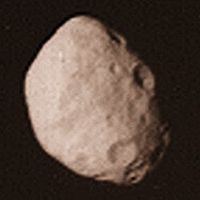 |
Saturn X | Dollfus Audouin Dollfus Audouin Charles Dollfus was a French astronomer and aeronaut, specialist in studies of the solar system and discoverer of Janus, a moon of Saturn.-Astronomical Career and Research:... |
| i: December 18, 1966 |
Epimetheus Epimetheus (moon) Epimetheus is an inner satellite of Saturn. It is also known as Saturn XI. It is named after the mythological Epimetheus, brother of Prometheus.-Discovery:Epimetheus occupies essentially the same orbit as the moon Janus... * |
S/1980 S 3 |  |
Saturn XI | Walker |
| 1970s | |||||
| i: September 11, 1974 |
Leda Leda (moon) Leda , also known as ', is a prograde irregular satellite of Jupiter. It was discovered by Charles T. Kowal at the Mount Palomar Observatory on September 14, 1974, after three nights' worth of photographic plates had been taken... |
— | — | Jupiter XIII | Kowal Charles T. Kowal Charles Thomas Kowal was an American astronomer.He discovered two moons of Jupiter: Leda in 1974 and Themisto in 1975, although the latter was lost and not rediscovered until 2000.... |
| i: September 30, 1975 |
Themisto Themisto (moon) Themisto , also known as ', is a small prograde irregular satellite of Jupiter. It was discovered in 1975, lost, and then rediscovered in 2000.- Discovery and naming :... * |
S/1975 J 1 | Jupiter XVIII | Kowal |
|
| i: April 13, 1978 |
Charon Charon (moon) Charon is the largest satellite of the dwarf planet Pluto. It was discovered in 1978 at the United States Naval Observatory Flagstaff Station. Following the 2005 discovery of two other natural satellites of Pluto , Charon may also be referred to as Pluto I... |
S/1978 P 1 | Pluto I | Christy James W. Christy James Walter Christy is an American astronomer.On June 22, 1978 while working at the United States Naval Observatory, he discovered that Pluto had a moon, which he named Charon shortly afterwards... |
|
| i: July 8, 1979 |
Adrastea Adrastea (moon) Adrastea , also known as ', is the second by distance, and the smallest of the four inner moons of Jupiter. It was discovered in Voyager 2 probe photographs taken in 1979, making it the first natural satellite to be discovered from images taken by an interplanetary spacecraft, rather than... |
S/1979 J 1 | 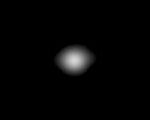 |
Jupiter XV | Jewitt David C. Jewitt David C. Jewitt is a professor of astronomy formerly at the University of Hawaii Institute for Astronomy, now at UCLA. He was born in 1958 in England, and is a 1979 graduate of the University of London. Jewitt received an M.Sc. and a Ph.D. in astronomy at the California Institute of Technology in... , Danielson / Voyager 2 Voyager 2 The Voyager 2 spacecraft is a 722-kilogram space probe launched by NASA on August 20, 1977 to study the outer Solar System and eventually interstellar space... |
| 1980s | |||||
| Date | Name | Temporary designation | Image | Permanent designation | Discoverer(s) and notes |
| i: February 26, 1980 |
Epimetheus Epimetheus (moon) Epimetheus is an inner satellite of Saturn. It is also known as Saturn XI. It is named after the mythological Epimetheus, brother of Prometheus.-Discovery:Epimetheus occupies essentially the same orbit as the moon Janus... * |
S/1980 S 3 |  |
Saturn XI | Voyager 1 The Voyager 1 spacecraft is a 722-kilogram space probe launched by NASA in 1977, to study the outer Solar System and eventually interstellar space. Operating for as of today , the spacecraft receives routine commands and transmits data back to the Deep Space Network. At a distance of as of... ) |
| i: March 1, 1980 |
Helene Helene (moon) Helene is a moon of Saturn. It was discovered by Pierre Laques and Jean Lecacheux in 1980 from ground-based observations at Pic du Midi Observatory, and was designated . In 1988 it was officially named after Helen of Troy, who was the granddaughter of Cronus in Greek mythology... |
S/1980 S 6 |  |
Saturn XII | Laques, Lecacheux |
| i: April 8, 1980 |
Telesto Telesto (moon) Telesto is a moon of Saturn. It was discovered by Smith, Reitsema, Larson and Fountain in 1980 from ground-based observations, and was provisionally designated '. In the following months, several other apparitions were observed: , , and .... |
S/1980 S 13 | 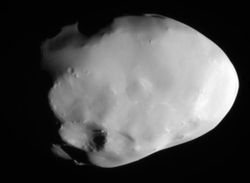 |
Saturn XIII | Smith, Reitsema Harold Reitsema Harold James Reitsema is an American astronomer who was part of the teams that discovered Larissa, the fifth of Neptune's known moons, and Telesto, Saturn's thirteenth moon. Reitsema and his colleagues discovered the moons through ground-based telescopic observations... , Larson, Fountain, Voyager 1 |
| i: March 5, 1979 |
Thebe Thebe (moon) Thebe also known as ', is the fourth of Jupiter's moons by distance from the planet. It was discovered by Stephen P. Synnott in images from the Voyager 1 space probe taken on March 5, 1979, while orbiting around Jupiter... |
S/1979 J 2 | 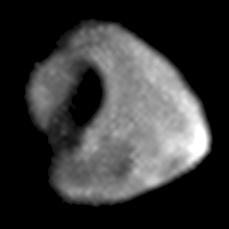 |
Jupiter XIV | Synnott Stephen P. Synnott Stephen P. Synnott is an American astronomer Voyager scientist who discovered several moons of Jupiter, Saturn, Uranus, and Neptune.He discovered Metis, Puck, Larissa , Proteus, and Thebe.-References:... , Voyager 1 |
| i: February 19, 1980 |
Janus Janus (moon) Janus is an inner satellite of Saturn. It is also known as Saturn X . It is named after the mythological Janus.-Discovery and orbit:Janus occupies practically the same orbit as the moon Epimetheus... * |
S/1980 S 1 |  |
Saturn X | |
| i: March 13, 1980 |
Calypso Calypso (moon) Calypso is a moon of Saturn. It was discovered in 1980, from ground-based observations, by Dan Pascu, P. Kenneth Seidelmann, William A. Baum, and Douglas G. Currie, and was provisionally designated ' . Several other apparitions of it were recorded in the following months: , , , and... |
S/1980 S 25 |  |
Saturn XIV | Pascu, Seidelmann, Baum, Currie |
| i:March 4, 1979 |
Metis Metis (moon) Metis , also known as ', is the innermost moon of Jupiter. It was discovered in 1979 in images taken by Voyager 1, and was named in 1983 after the first wife of Zeus, Metis... |
S/1979 J 3 |  |
Jupiter XVI | Synnott, Voyager 1 |
| o: October, 1980 |
Prometheus Prometheus (moon) -Animations:-External links:* at ** anaglyph view of Prometheus... |
S/1980 S 27 | 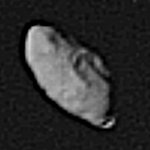 |
Saturn XVI | Collins, Voyager 1 |
| Pandora Pandora (moon) Pandora is an inner satellite of Saturn. It was discovered in 1980 from photos taken by the Voyager 1 probe, and was provisionally designated '. In late 1985 it was officially named after Pandora from Greek mythology. It is also designated as '.Pandora is the outer shepherd satellite of the F Ring... |
S/1980 S 26 | 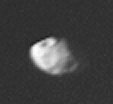 |
Saturn XVII | Collins, Voyager 1 | |
| o: October, 1980 |
Atlas Atlas (moon) Atlas is an inner satellite of Saturn.Atlas was discovered by Richard Terrile in 1980 from Voyager photos and was designated '. In 1983 it was officially named after Atlas of Greek mythology, because it "holds the rings on its shoulders" like the Titan Atlas held the sky up above the Earth... |
S/1980 S 28 | 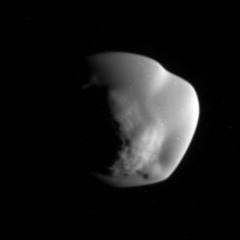 |
Saturn XV | Terrile Richard J. Terrile Richard John Terrile is a Voyager scientist who discovered several moons of Saturn, Uranus, and Neptune. He works for NASA's Jet Propulsion Laboratory.-References:... , Voyager 1 |
| i: May 24, 1981 |
Larissa Larissa (moon) Larissa , also known as Neptune VII, is the fifth-closest inner satellite of Neptune. It is named after Larissa, a lover of Poseidon in Greek mythology and eponymous nymph of the city in Thessaly.- Discovery :... * |
S/1981 N 1 |
 |
Neptune VII | Reitsema, Hubbard, Lebofsky, Tholen David J. Tholen David James Tholen is an American astronomer at the Institute for Astronomy of the University of Hawaii, who specializes in planetary and solar system astronomy.-Professional life:... , Voyager 2 Voyager 2 The Voyager 2 spacecraft is a 722-kilogram space probe launched by NASA on August 20, 1977 to study the outer Solar System and eventually interstellar space... |
| i: December 30, 1985 |
Puck Puck (moon) Puck is an inner moon of Uranus. It was discovered in December 1985 by the Voyager 2 spacecraft. The name Puck comes from Celtic mythology and English folklore. The orbit of Puck lies between the rings of Uranus and the first of Uranus' large moons, Miranda. Puck is approximately spherical in... |
S/1985 U 1 |  |
Uranus XV | Synnott, Voyager 2 |
| i: January 3, 1986 |
Juliet Juliet (moon) Juliet is an inner satellite of Uranus. It was discovered from the images taken by Voyager 2 on 3 January 1986, and was given the temporary designation S/1986 U 2. It is named after the heroine of William Shakespeare's play Romeo and Juliet... |
S/1986 U 2 |  |
Uranus XI | Synnott, Voyager 2 |
| Portia Portia (moon) Portia is an inner satellite of Uranus. It was discovered from the images taken by Voyager 2 on 3 January 1986, and was given the temporary designation S/1986 U 1. The moon is named after Portia, the heroine of William Shakespeare's play The Merchant of Venice... |
S/1986 U 1 | 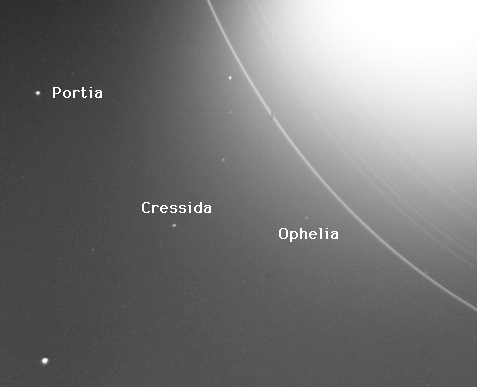 |
Uranus XII | ||
| i: January 9, 1986 |
Cressida Cressida (moon) Cressida is an inner satellite of Uranus. It was discovered from the images taken by Voyager 2 on 9 January 1986, and was given the temporary designation S/1986 U 3. It was named after the Trojan daughter of Calchas, a tragic heroine who appears in William Shakespeare's play Troilus and... |
S/1986 U 3 | Uranus IX | ||
| i: January 13, 1986 |
Desdemona Desdemona (moon) Desdemona is an inner satellite of Uranus. It was discovered from the images taken by Voyager 2 on 13 January 1986, and was given the temporary designation S/1986 U 6. Desdemona is named after the wife of Othello in William Shakespeare's play Othello... |
S/1986 U 6 | 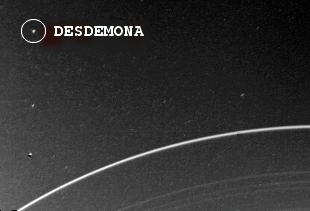 |
Uranus X | |
| Rosalind Rosalind (moon) Rosalind is an inner satellite of Uranus. It was discovered from the images taken by Voyager 2 on 13 January 1986, and was given the temporary designation S/1986 U 4. It was named after the daughter of the banished Duke in William Shakespeare's play As You Like It... |
S/1986 U 4 | Uranus XIII | |||
| Belinda Belinda (moon) - External links :* by *... |
S/1986 U 5 | 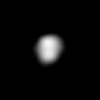 |
Uranus XIV | ||
| i: January 20, 1986 |
Cordelia Cordelia (moon) Cordelia is the innermost moon of Uranus. It was discovered from the images taken by Voyager 2 on January 20, 1986, and was given the temporary designation S/1986 U 7. It was not detected again until the Hubble Space Telescope observed it in 1997... |
S/1986 U 7 | 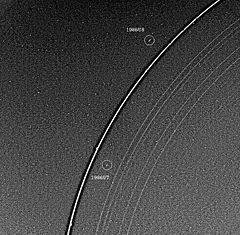 |
Uranus VI | Terrile Richard J. Terrile Richard John Terrile is a Voyager scientist who discovered several moons of Saturn, Uranus, and Neptune. He works for NASA's Jet Propulsion Laboratory.-References:... , Voyager 2 |
| Ophelia Ophelia (moon) Ophelia is a moon of Uranus. It was discovered from the images taken by Voyager 2 on January 20, 1986, and was given the temporary designation S/1986 U 8. It was not seen until the Hubble Space Telescope recovered it in 2003. Ophelia was named after the daughter of Polonius, Ophelia, in... |
S/1986 U 8 | Uranus VII | |||
| i: January 23, 1986 |
Bianca Bianca (moon) Bianca is an inner satellite of Uranus. It was discovered from the images taken by Voyager 2 on January 23, 1986, and was given the temporary designation S/1986 U 9. It was named after the sister of Katherine in Shakespeare's play The Taming of the Shrew... |
S/1986 U 9 | Uranus VIII | Smith, Voyager 2 | |
| i: June 16, 1989 |
Proteus Proteus (moon) Proteus , also known as Neptune VIII, is the second largest Neptunian moon, and Neptune's largest inner satellite. Discovered by Voyager 2 spacecraft in 1989, it is named after Proteus, the shape-changing sea god of Greek mythology... |
S/1989 N 1 | .jpg) |
Neptune VIII | Synnott, Voyager 2 |
| i: July 28, 1989 |
Despina Despina (moon) Despina , also known as Neptune V, is the third closest inner satellite of Neptune. It is named after Despoina, a nymph who was a daughter of Poseidon and Demeter.... |
S/1989 N 3 | 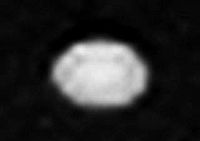 |
Neptune V | Synnott, Voyager 2 |
| Galatea Galatea (moon) Galatea , also known as Neptune VI, is the fourth closest inner satellite of Neptune. It is named after Galatea, one of the Nereids of Greek legend.Galatea was discovered in late July 1989 from the images taken by the Voyager 2 probe... |
S/1989 N 4 | 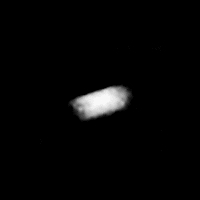 |
Neptune VI | ||
| i: September 18, 1989 |
Thalassa Thalassa (moon) Thalassa , also known as Neptune IV, is the second innermost satellite of Neptune. Thalassa was named after sea goddesss Thalassa, a daughter of Aether and Hemera from Greek mythology. "Thalassa" is also the Greek word for "sea".... |
S/1989 N 5 |  |
Neptune IV | Terrile, Voyager 2 |
| Naiad Naiad (moon) Naiad , also known as Neptune III, is the innermost satellite of Neptune, named after the Naiads of Greek legend.Naiad was discovered sometime before mid-September 1989 from the images taken by the Voyager 2 probe. The last moon to be discovered during the flyby, it was designated... |
S/1989 N 6 | Neptune III | |||
| 1990s | |||||
| Date | Name | Temporary designation | Image | Permanent designation | Discoverer(s) and notes |
| i: August 22, 1981 |
Pan Pan (moon) Pan is the innermost moon of Saturn. It is a walnut-shaped small moon about 35 kilometres across and 23 km high that orbits within the Encke Gap in Saturn's A Ring. Pan acts as a ring shepherd and is responsible for keeping the Encke Gap free of ring particles.It was discovered by Mark R... * |
S/1981 S 13 | Saturn XVIII | Showalter, Voyager 2 Voyager 2 The Voyager 2 spacecraft is a 722-kilogram space probe launched by NASA on August 20, 1977 to study the outer Solar System and eventually interstellar space... |
|
| i: August 23, 1981 |
Pallene Pallene (moon) Pallene is a very small natural satellite of Saturn. It is one of three small moons known as the Alkyonides that lie between the orbits of the larger Mimas and Enceladus. It is also designated as '.-Discovery:... * |
S/1981 S 14 | Saturn XXXIII | Gordon, Murray and Beurle Kevin Beurle Dr Kevin Beurle was a British space scientist and programmer at Queen Mary, University of London, who played a key role in the Cassini–Huygens mission to study Saturn and its moons. He was a specialist in space imaging systems... |
|
| i: September 6, 1997 |
Caliban Caliban (moon) Caliban is the second largest retrograde irregular moon of Uranus. It was discovered on 6 September 1997 by Brett J. Gladman, Philip D. Nicholson, Joseph A. Burns, and John J... |
S/1997 U 1 | Uranus XVI | Gladman Brett J. Gladman Brett J. Gladman is a Canadian astronomer and a full professor at the University of British Columbia's Department of Physics and Astronomy in Vancouver, British Columbia. He holds the Canada Research Chair in Planetary Astronomy.-Career:... , Nicholson Phil Nicholson Philip D. Nicholson is a Professor of Astronomy at Cornell University in the Astronomy department specialising in Planetary Sciences. He was part of the team led by Brett J. Gladman that discovered several moons of Uranus and Saturn. He has been editor-in-chief of the journal Icarus since 1998.-... , Burns Joseph A. Burns Joseph Burns is a professor at Cornell University with a dual appointment in the Department of Theoretical and Applied Mechanics and the Astronomy department. His primary area of research is dynamics in planetary sciences.- Professional biography :... , Kavelaars John J. Kavelaars John J. Kavelaars, better known as JJ Kavelaars, is a Canadian astronomer who was part of a team that discovered several moons of Jupiter, Saturn, Uranus, and Neptune.... |
|
| Sycorax Sycorax (moon) Sycorax is the largest retrograde irregular satellite of Uranus. Sycorax was discovered on 6 September 1997 by Brett J. Gladman, Philip D. Nicholson, Joseph A. Burns, and John J... |
S/1997 U 2 | Uranus XVII | Gladman, Nicholson, Burns, Kavelaars | ||
| i: January 18, 1986 |
Perdita Perdita (moon) Perdita is an inner satellite of Uranus. Perdita's discovery was complicated. The first photographs of Perdita were taken by the Voyager 2 spacecraft in 1986, but it was not recognized from the photographs for more than a decade. In 1999, the moon was noticed by Erich Karkoschka and reported... * |
S/1986 U 10 | Uranus XXV | Karkoschka Erich Karkoschka Erich Karkoschka is a planetary researcher at the Lunar and Planetary Lab of the University of Arizona. He discovered a satellite of Uranus, S/1986 U 10 on photographs taken by the Voyager 2 spacecraft... , Voyager 2 |
|
| i: July 18, 1999 p: July 27, 1999 |
Setebos Setebos (moon) Setebos is one of the outermost retrograde irregular satellites of Uranus. It was discovered on 18 July 1999 by John J. Kavelaars et al. and provisionally designated S/1999 U 1.... |
S/1999 U 1 | — | Uranus XIX | Kavelaars, Gladman, Holman Matthew J. Holman Matthew J. Holman is a Smithsonian Astrophysicist and lecturer at Harvard University. Holman studied at MIT, where he received his bachelor's degree in mathematics in 1989 and his PhD in planetary science in 1994.... , Petit, Scholl Hans Scholl (astronomer) Hans Scholl, born 1942, is a German astronomer working at the Côte d'Azur Observatory in Nice, France. In 1999, he was part of a team that discovered the satellites Prospero, Setebos and Stephano of the planet Uranus.-External links:*-References:... |
| Stephano Stephano (moon) Stephano is a retrograde irregular satellite of Uranus. It was discovered by Brett J. Gladman, et al. in 1999, and given the provisional designation S/1999 U 2.... |
S/1999 U 2 | — | Uranus XX | Gladman, Holman, Kavelaars, Petit, Scholl | |
| i: July 18, 1999 |
Prospero Prospero (moon) Prospero is a relatively small retrograde irregular satellite of Uranus discovered on 18 July 1999 by the astrophysicist Matthew Holman and his team, and given the provisional designation S/1999 U 3... |
S/1999 U 3 | Uranus XVIII | Holman, Kavelaars, Gladman, Petit, Scholl | |
| 2000s | |||||
| Date | Name | Temporary designation | Image | Permanent designation | Discoverer(s) and notes |
| i: October 6, 1999 |
Callirrhoe Callirrhoe (moon) Callirrhoe , also known as ' , is one of Jupiter's outermost named natural satellites. It is an irregular moon that orbits in a retrograde direction. Callirrhoe was imaged by Spacewatch at Kitt Peak National Observatory from October 6 through November 4, 1999, and originally designated as asteroid... |
S/1999 J 1 | Jupiter XVII | Scotti James V. Scotti James Vernon Scotti is an American astronomer. He was born in Bandon, Oregon and graduated from Woodway Senior High in Edmonds, Washington in 1978. He received his B.Sc. in Astronomy from the University of Arizona in Tucson in 1983. Ever since that time, he has worked on the Spacewatch project,... , Spahr Timothy B. Spahr Timothy B. Spahr is an American astronomer.He works at the Harvard-Smithsonian Center for Astrophysics as director of the Minor Planet Center, has discovered numerous asteroids and is credited as a co-discoverer of one satellite of Jupiter and one of Saturn .He also discovered two periodic comets... , McMillan Robert S. McMillan Robert S. McMillan is an astronomer at the University of Arizona, and heads the Spacewatch project, which studies minor planets. He has made various discoveries, including notably 20000 Varuna.... , Larsen, Montani, Gleason, Gehrels Tom Gehrels Tom Gehrels , was an American astronomer, Professor Planetary Sciences, and Astronomer at the University of Arizona, Tucson.... |
|
| i: August 7, 2000 |
Ymir Ymir (moon) Ymir , or Saturn XIX, is a retrograde irregular moon of Saturn. It was discovered by Brett J. Gladman, et al. in 2000, and given the temporary designation S/2000 S 1... |
S/2000 S 1 | — | Saturn XIX | Gladman Brett J. Gladman Brett J. Gladman is a Canadian astronomer and a full professor at the University of British Columbia's Department of Physics and Astronomy in Vancouver, British Columbia. He holds the Canada Research Chair in Planetary Astronomy.-Career:... |
| Paaliaq Paaliaq (moon) Paaliaq is a prograde irregular satellite of Saturn. It was discovered by Brett J. Gladman, John J. Kavelaars, Jean-Marc Petit, Hans Scholl, Matthew J. Holman, Brian G. Marsden, Philip D. Nicholson and Joseph A. Burns in early October 2000, and given the temporary designation S/2000 S 2... |
S/2000 S 2 | — | Saturn XX | ||
| i: September 23, 2000 |
Siarnaq Siarnaq (moon) Siarnaq , or Saturn XXIX, is a prograde irregular satellite of Saturn. It was discovered by Brett J. Gladman, et al. in 2000, and given the temporary designation S/2000 S 3.... |
S/2000 S 3 | — | Saturn XXIX | Gladman, Kavelaars John J. Kavelaars John J. Kavelaars, better known as JJ Kavelaars, is a Canadian astronomer who was part of a team that discovered several moons of Jupiter, Saturn, Uranus, and Neptune.... |
| Tarvos Tarvos (moon) Tarvos , or Saturn XXI, is a prograde irregular satellite of Saturn. It was discovered by John J. Kavelaars et al. on September 23, 2000, and given the temporary designation S/2000 S 4... |
S/2000 S 4 | Saturn XXI | Kavelaars, Gladman | ||
| i: August 7, 2000 |
Kiviuq Kiviuq (moon) Kiviuq is a prograde irregular satellite of Saturn. It was discovered by Brett J. Gladman in 2000, and given the temporary designation S/2000 S 5. It was named after Kiviuq, a hero of Inuit mythology.... |
S/2000 S 5 | — | Saturn XXIV | Gladman |
| i: September 23, 2000 |
Ijiraq Ijiraq (moon) Ijiraq , or Saturn XXII , is small prograde irregular satellite of Saturn. It was discovered by the team ofBrett Gladman, John J. Kavelaars, et al. in 2000, and given the temporary designation '... |
S/2000 S 6 | Saturn XXII | Kavelaars, Gladman | |
| i: November 21, 2000 |
Themisto Themisto (moon) Themisto , also known as ', is a small prograde irregular satellite of Jupiter. It was discovered in 1975, lost, and then rediscovered in 2000.- Discovery and naming :... * |
S/2000 J 1 | Jupiter XVIII | Sheppard Scott S. Sheppard Scott S. Sheppard is an astronomer in the Department of Terrestrial Magnetism at the Carnegie Institution for Science. Starting as a graduate student at the Institute for Astronomy at the University of Hawaii, he was credited with the discovery of many small moons of Jupiter, Saturn, Uranus, and... , Jewitt David C. Jewitt David C. Jewitt is a professor of astronomy formerly at the University of Hawaii Institute for Astronomy, now at UCLA. He was born in 1958 in England, and is a 1979 graduate of the University of London. Jewitt received an M.Sc. and a Ph.D. in astronomy at the California Institute of Technology in... , Fernández Yanga R. Fernández Yanga Roland Fernández is a Canadian-American astronomer at the University of Central Florida.Together with Scott S. Sheppard, he co-discovered the Carme group, a group of moons of the planet Jupiter.... , Magnier (Rediscovered) |
|
| i: September 23, 2000 |
Thrymr | S/2000 S 7 | Saturn XXX | Gladman, Kavelaars | |
| Skathi Skathi (moon) Skathi , or Saturn XXVII, is a natural satellite of Saturn. It was discovered by Brett Gladman, Kavelaars, et al. in 2000, and given the temporary designation S/2000 S 8.... |
S/2000 S 8 | — | Saturn XXVII | Kavelaars, Gladman | |
| Mundilfari Mundilfari (moon) Mundilfari , or Saturn XXV, is a natural satellite of Saturn. It was discovered by Brett J. Gladman, et al. in 2000, and given the temporary designation S/2000 S 9.... |
S/2000 S 9 | Saturn XXV | Gladman, Kavelaars | ||
| Erriapus | S/2000 S 10 | — | Saturn XXVIII | Kavelaars, Gladman | |
| i: November 9, 2000 |
Albiorix Albiorix (moon) Albiorix is a prograde irregular satellite of Saturn. It was discovered by Holman, et al. in 2000, and given the temporary designation S/2000 S 11.Albiorix is the largest member of the Gallic group of irregular satellites.... |
S/2000 S 11 | — | Saturn XXVI | Holman Matthew J. Holman Matthew J. Holman is a Smithsonian Astrophysicist and lecturer at Harvard University. Holman studied at MIT, where he received his bachelor's degree in mathematics in 1989 and his PhD in planetary science in 1994.... , Spahr |
| i: September 23, 2000 |
Suttungr Suttungr (moon) Suttungr , or Saturn XXIII, is a natural satellite of Saturn. It was discovered by Brett J. Gladman, et al. in 2000, and given the temporary designation S/2000 S 12... |
S/2000 S 12 | — | Saturn XXIII | Gladman, Kavelaars |
| Date | Name | Temporary designation | Image | Permanent designation | Discoverer(s) and notes |
2000s
| 2000s | |||||
|---|---|---|---|---|---|
| Date | Name | Temporary designation | Image | Permanent designation | Discoverer(s) and notes |
i: November 23, 2000 |
Kalyke Kalyke (moon) Kalyke , also known as ', is a retrograde irregular satellite of Jupiter. It was discovered by a team of astronomers from the University of Hawaii led by Scott S... |
S/2000 J 2 | — | Jupiter XXIII | Sheppard Scott S. Sheppard Scott S. Sheppard is an astronomer in the Department of Terrestrial Magnetism at the Carnegie Institution for Science. Starting as a graduate student at the Institute for Astronomy at the University of Hawaii, he was credited with the discovery of many small moons of Jupiter, Saturn, Uranus, and... , Jewitt David C. Jewitt David C. Jewitt is a professor of astronomy formerly at the University of Hawaii Institute for Astronomy, now at UCLA. He was born in 1958 in England, and is a 1979 graduate of the University of London. Jewitt received an M.Sc. and a Ph.D. in astronomy at the California Institute of Technology in... , Fernández Yanga R. Fernández Yanga Roland Fernández is a Canadian-American astronomer at the University of Central Florida.Together with Scott S. Sheppard, he co-discovered the Carme group, a group of moons of the planet Jupiter.... , Magnier, Dahm, Evans |
| Iocaste Iocaste (moon) Iocaste , also known as ', is a retrograde irregular satellite of Jupiter. It was discovered by a team of astronomers from the University of Hawaii led by Scott S... |
S/2000 J 3 | — | Jupiter XXIV | ||
| Erinome Erinome (moon) Erinome , also known as ', is a retrograde irregular satellite of Jupiter. It was discovered by a team of astronomers from the University of Hawaii led by Scott S... |
S/2000 J 4 | — | Jupiter XXV | ||
| Harpalyke Harpalyke (moon) Harpalyke , also known as ', is a retrograde irregular satellite of Jupiter. It was discovered by a team of astronomers from the University of Hawaii led by Scott S. Sheppard in 2000, and given the temporary designation '... |
S/2000 J 5 | — | Jupiter XXII | ||
| Isonoe Isonoe (moon) Isonoe , also known as ', is a retrograde irregular satellite of Jupiter. It was discovered by a team of astronomers from the University of Hawaii led by Scott S... |
S/2000 J 6 | — | Jupiter XXVI | ||
| Praxidike Praxidike (moon) Praxidike , also known as ', is a retrograde irregular satellite of Jupiter. It was discovered by a team of astronomers from the University of Hawaii led by Scott S... |
S/2000 J 7 | — | Jupiter XXVII | ||
| i: November 25, 2000 |
Megaclite Megaclite (moon) Megaclite , also known as ', is a natural satellite of Jupiter. It was discovered by a team of astronomers from the University of Hawaii led by Scott S... |
S/2000 J 8 | — | Jupiter XIX | Sheppard, Jewitt, Fernández, Magnier, Dahm, Evans |
| Taygete Taygete (moon) Taygete , also known as ', is a retrograde irregular satellite of Jupiter. It was discovered by a team of astronomers from the University of Hawaii led by Scott S... |
S/2000 J 9 | — | Jupiter XX | ||
| i: November 26, 2000 |
Chaldene Chaldene (moon) Chaldene , also known as ', is a retrograde irregular satellite of Jupiter. It was discovered by a team of astronomers from the University of Hawaii led by Scott S... |
S/2000 J 10 | — | Jupiter XXI | |
| Date | Name | Temporary designation | Image | Permanent designation | Discoverer(s) and notes |
| i: December 9, 2001 |
Hermippe Hermippe (moon) Hermippe , or ', is a natural satellite of Jupiter. It was discovered by a team of astronomers from the University of Hawaii led by Scott S... |
S/2001 J 3 | Jupiter XXX | Sheppard Scott S. Sheppard Scott S. Sheppard is an astronomer in the Department of Terrestrial Magnetism at the Carnegie Institution for Science. Starting as a graduate student at the Institute for Astronomy at the University of Hawaii, he was credited with the discovery of many small moons of Jupiter, Saturn, Uranus, and... , Jewitt David C. Jewitt David C. Jewitt is a professor of astronomy formerly at the University of Hawaii Institute for Astronomy, now at UCLA. He was born in 1958 in England, and is a 1979 graduate of the University of London. Jewitt received an M.Sc. and a Ph.D. in astronomy at the California Institute of Technology in... , Kleyna Jan Kleyna Jan Kleyna is a postdoctoral astronomy researcher at the University of Hawaii Institute for Astronomy. His area of interest is galaxy dynamics, and he has worked to develop codes for the real-time detection of moving objects such as Jovian satellites. He has also co-discovered several of... |
|
| Eurydome Eurydome (moon) Eurydome , also known as ', is a natural satellite of Jupiter. It was discovered by a team of astronomers from the University of Hawaii led by Scott S... |
S/2001 J 4 | — | Jupiter XXXII | ||
| Sponde Sponde (moon) Sponde , also known as ', is a natural satellite of Jupiter. It was discovered by a team of astronomers from the University of Hawaii led by Scott S... |
S/2001 J 5 | — | Jupiter XXXVI | ||
| Kale Kale (moon) Kale , also known as ', is a retrograde irregular satellite of Jupiter. It was discovered in 2001 by astronomers S. Sheppard, D. Jewitt, and J... |
S/2001 J 8 | — | Jupiter XXXVII | ||
| i: December 10, 2001 |
Autonoe Autonoe (moon) Autonoe , also known as ', is a natural satellite of Jupiter. It was discovered by a team of astronomers from the University of Hawaii led by Scott S... |
S/2001 J 1 | — | Jupiter XXVIII | |
| i: December 11, 2001 |
Thyone Thyone (moon) Thyone , also known as ', is a retrograde irregular satellite of Jupiter. It was discovered by a team of astronomers from the University of Hawaii led by Scott S. Sheppard, et al... |
S/2001 J 2 | — | Jupiter XXIX | |
| Pasithee Pasithee (moon) Pasithee , also known as ', is a retrograde irregular satellite of Jupiter. It was discovered by a team of astronomers from the University of Hawaii led by Scott S... |
S/2001 J 6 | — | Jupiter XXXVIII | ||
| Euanthe Euanthe (moon) Euanthe , also known as ', is a retrograde irregular satellite of Jupiter. It was discovered by a team of astronomers from the University of Hawaii led by Scott S... |
S/2001 J 7 | — | Jupiter XXXIII | ||
| Orthosie Orthosie (moon) Orthosie , also known as ', is a natural satellite of Jupiter. It was discovered by a team of astronomers from the University of Hawaii led by Scott S... |
S/2001 J 9 | — | Jupiter XXXV | ||
| Euporie Euporie (moon) Euporie , also known as ', is a natural satellite of Jupiter. It was discovered by a team of astronomers from the University of Hawaii led by Scott S... |
S/2001 J 10 | — | Jupiter XXXIV | ||
| Aitne Aitne (moon) Aitne , also known as ', is a retrograde irregular satellite of Jupiter. It was discovered by a team of astronomers from the University of Hawaii led by Scott S. Sheppard, et al. in 2001, and given the temporary designation '... |
S/2001 J 11 | — | Jupiter XXXI | ||
| i: August 13, 2001 |
Trinculo Trinculo (moon) Trinculo is a retrograde irregular satellite of Uranus. It was discovered by Holman, et al. on 13 August 2001, and given the temporary designation S/2001 U 1.... |
S/2001 U 1 | Uranus XXI | Holman Matthew J. Holman Matthew J. Holman is a Smithsonian Astrophysicist and lecturer at Harvard University. Holman studied at MIT, where he received his bachelor's degree in mathematics in 1989 and his PhD in planetary science in 1994.... , Kavelaars John J. Kavelaars John J. Kavelaars, better known as JJ Kavelaars, is a Canadian astronomer who was part of a team that discovered several moons of Jupiter, Saturn, Uranus, and Neptune.... , Milisavljevic Dan Milisavljevic Dan Milisavljevic is a Canadian astronomer known for aiding in the discovery of Uranus's moons Ferdinand, Trinculo, and Francisco; and Neptune's moons Halimede, Sao, Laomedeia and Neso.... |
|
| i: October 31, 2002 |
Arche Arche (moon) Arche , also known as ', is a moon of Jupiter. It was discovered by a team of astronomers from the University of Hawaii led by Scott S. Sheppard in 2002, and received the temporary designation '.... |
S/2002 J 1 | — | Jupiter XLIII | Sheppard, Meech Karen Jean Meech Karen J. Meech is an astronomer at the Institute for Astronomy in the University of Hawaii. Meech specializes in planetary astronomy, in particular the study of distant comets and their relation to the early solar system... , Hsieh, Tholen David J. Tholen David James Tholen is an American astronomer at the Institute for Astronomy of the University of Hawaii, who specializes in planetary and solar system astronomy.-Professional life:... , Tonry |
| Date | Name | Temporary designation | Image | Permanent designation | Discoverer(s) and notes |
| i: July 23, 2002 |
Sao | S/2002 N 2 | — | Neptune XI | Holman Matthew J. Holman Matthew J. Holman is a Smithsonian Astrophysicist and lecturer at Harvard University. Holman studied at MIT, where he received his bachelor's degree in mathematics in 1989 and his PhD in planetary science in 1994.... , Kavelaars John J. Kavelaars John J. Kavelaars, better known as JJ Kavelaars, is a Canadian astronomer who was part of a team that discovered several moons of Jupiter, Saturn, Uranus, and Neptune.... , Grav, Fraser, Milisavljevic Dan Milisavljevic Dan Milisavljevic is a Canadian astronomer known for aiding in the discovery of Uranus's moons Ferdinand, Trinculo, and Francisco; and Neptune's moons Halimede, Sao, Laomedeia and Neso.... |
| i: August 10, 2002 |
Halimede | S/2002 N 1 | — | Neptune IX | |
| i: August 11, 2002 |
Laomedeia | S/2002 N 3 | — | Neptune XII | |
| i: February 5, 2003 |
Eukelade Eukelade (moon) Eukelade , also known as ', is a retrograde irregular satellite of Jupiter. It was discovered by a team of astronomers from the University of Hawaii led by Scott S... |
S/2003 J 1 | — | Jupiter XLVII | Sheppard Scott S. Sheppard Scott S. Sheppard is an astronomer in the Department of Terrestrial Magnetism at the Carnegie Institution for Science. Starting as a graduate student at the Institute for Astronomy at the University of Hawaii, he was credited with the discovery of many small moons of Jupiter, Saturn, Uranus, and... , Jewitt David C. Jewitt David C. Jewitt is a professor of astronomy formerly at the University of Hawaii Institute for Astronomy, now at UCLA. He was born in 1958 in England, and is a 1979 graduate of the University of London. Jewitt received an M.Sc. and a Ph.D. in astronomy at the California Institute of Technology in... , Kleyna Jan Kleyna Jan Kleyna is a postdoctoral astronomy researcher at the University of Hawaii Institute for Astronomy. His area of interest is galaxy dynamics, and he has worked to develop codes for the real-time detection of moving objects such as Jovian satellites. He has also co-discovered several of... , Fernández Yanga R. Fernández Yanga Roland Fernández is a Canadian-American astronomer at the University of Central Florida.Together with Scott S. Sheppard, he co-discovered the Carme group, a group of moons of the planet Jupiter.... , Hsieh |
| (unnamed moons of Jupiter) | S/2003 J 2 S/2003 J 2 ' is a retrograde irregular satellite of Jupiter. The discovery, by a team of astronomers from the University of Hawaii led by Scott S. Sheppard and David C. Jewitt, was announced on March 4, 2003... |
— | — | ||
| S/2003 J 3 S/2003 J 3 ' is a natural satellite of Jupiter. It was discovered by a team of astronomers from the University of Hawaii led by Scott S. Sheppard in 2003. is about 2 kilometres in diameter, and orbits Jupiter at an average distance of 19,622 Mm in 561.518 days, at an inclination of 146° to the ecliptic , in a... |
— | ||||
| S/2003 J 4 S/2003 J 4 ' is a natural satellite of Jupiter. It was discovered by a team of astronomers from the University of Hawaii led by Scott S. Sheppard in 2003. is about 2 km in diameter, and orbits Jupiter at an average distance of 23,571 Mm in 739.294 days, at an inclination of 147° to the ecliptic , in a... |
— | ||||
| i: February 6, 2003 |
(unnamed moon of Jupiter) | S/2003 J 5 S/2003 J 5 ' is a retrograde irregular satellite of Jupiter. It was discovered by a team of astronomers from the University of Hawaii led by Scott S. Sheppard in 2003.... |
— | — | |
| Helike Helike (moon) Helike , also known as ', is a moon of Jupiter. It was discovered by a team of astronomers from the University of Hawaii led by Scott S. Sheppard in 2003, and given the temporary designation '.... |
S/2003 J 6 | — | Jupiter XLV | ||
| i: February 8, 2003 |
Aoede Aoede (moon) Aoede , also known as ', is a natural satellite of Jupiter. It was discovered by a team of astronomers from the University of Hawaii led by Scott S. Sheppard in 2003... |
S/2003 J 7 | — | Jupiter XLI | |
| i: February 8, 2003 |
Hegemone Hegemone (moon) Hegemone , also known as ', is a natural satellite of Jupiter. It was discovered by a team of astronomers from the University of Hawaii led by Scott S... |
S/2003 J 8 | — | Jupiter XXXIX | Sheppard, Jewitt, Kleyna, Fernández |
| i: February 6, 2003 |
(unnamed moons of Jupiter) | S/2003 J 9 S/2003 J 9 ' is a retrograde irregular satellite of Jupiter. It was discovered by a team of astronomers from the University of Hawaii led by Scott S. Sheppard in 2003.... |
— | — | Sheppard, Jewitt, Kleyna, Fernández |
| S/2003 J 10 S/2003 J 10 ' is a retrograde irregular satellite of Jupiter. It was discovered by a team of astronomers from the University of Hawaii led by Scott S. Sheppard et al. in 2003.... |
— | ||||
| Kallichore Kallichore (moon) Kallichore , also known as ', is a natural satellite of Jupiter. It was discovered by a team of astronomers from the University of Hawaii led by Scott S. Sheppard, et al. in 2003... |
S/2003 J 11 | — | Jupiter XLIV | ||
| i: February 8, 2003 |
(unnamed moon of Jupiter) | S/2003 J 12 S/2003 J 12 ' is a natural satellite of Jupiter, and is the smallest known satellite in the Solar System. It was discovered by a team of astronomers from the University of Hawaii led by Scott S... |
— | — | |
| i: February 9, 2003 |
Cyllene Cyllene (moon) Cyllene , also known as ', is a natural satellite of Jupiter. It was discovered by a team of astronomers from the University of Hawaii led by Scott S... |
S/2003 J 13 | — | Jupiter XLVIII | Sheppard, Jewitt, Kleyna |
| i: February 8, 2003 |
Kore | S/2003 J 14 | — | Jupiter XLIX | Sheppard, Jewitt, Kleyna |
| i: February 6, 2003 |
(unnamed moons of Jupiter) | S/2003 J 15 S/2003 J 15 ' is a natural satellite of Jupiter. It was discovered by a team of astronomers from the University of Hawaii led by Scott S. Sheppard, et al. in 2003.... |
— | — | Sheppard, Jewitt, Kleyna, Fernández |
| S/2003 J 16 S/2003 J 16 ' is a natural satellite of Jupiter. It was discovered by a team of astronomers led by Brett J. Gladman in 2003. is about 2 kilometres in diameter, and orbits Jupiter at an average distance of 20,744 Mm in 610.362 days, at an inclination of 151° to the ecliptic , in a retrograde direction and with... |
— | Gladman Brett J. Gladman Brett J. Gladman is a Canadian astronomer and a full professor at the University of British Columbia's Department of Physics and Astronomy in Vancouver, British Columbia. He holds the Canada Research Chair in Planetary Astronomy.-Career:... , Sheppard, Jewitt, Kleyna, Kavelaars, Petit, Allen |
|||
| i: February 8, 2003 |
Herse | S/2003 J 17 | — | Jupiter L | Gladman, Sheppard, Jewitt, Kleyna, Kavelaars, Petit, Allen |
| i: February 6, 2003 |
(unnamed moon of Jupiter) | S/2003 J 18 S/2003 J 18 ' is a natural satellite of Jupiter. It was discovered by a team of astronomers led by Brett J. Gladman in 2003. is about 2 kilometres in diameter, and orbits Jupiter at an average distance of 19,813 Mm in 569.728 days, at an inclination of 147° to the ecliptic , in a retrograde direction and with... |
— | — | Gladman, Kavelaars, Petit, Allen, Sheppard, Jewitt, Kleyna |
| i: February 5, 2003 |
Narvi Narvi (moon) Narvi , or Saturn XXXI, is a natural satellite of Saturn. It was discovered by a team of astronomers led by Scott S. Sheppard in 2003, and given the temporary designation S/2003 S 1.- Description :... |
S/2003 S 1 | — | Saturn XXXI | Sheppard, Jewitt, Kleyna |
| i: February 6, 2003 |
(unnamed moon of Jupiter) | S/2003 J 19 S/2003 J 19 ' is a natural satellite of Jupiter. It was discovered by a team of astronomers led by Brett J. Gladman, et al. in 2003. is about 2 kilometres in diameter, and orbits Jupiter at an average distance of 22,709 Mm in 699.125 days, at an inclination of 165° to the ecliptic , in a retrograde direction... |
— | — | Gladman, Sheppard, Jewitt, Kleyna, Kavelaars, Petit, Allen |
| i: February 9, 2003 |
Carpo Carpo (moon) Carpo , also ', is a natural satellite of Jupiter. It was discovered by a team of astronomers from the University of Hawaii led by Scott S... |
S/2003 J 20 | — | Jupiter XLVI | Sheppard, Gladman, Kavelaars, Petit, Allen, Jewitt, Kleyna |
| i: February 6, 2003 |
Mneme Mneme (moon) Mneme , also known as ', is a retrograde irregular satellite of Jupiter. It was discovered by a team of astronomers from the University of Hawaii led by Scott S. Sheppard, et al... |
S/2003 J 21 | — | Jupiter XL | Sheppard, Jewitt, Kleyna, Gladman, Kavelaars, Petit, Allen |
| i: January 18, 1986 |
Perdita Perdita (moon) Perdita is an inner satellite of Uranus. Perdita's discovery was complicated. The first photographs of Perdita were taken by the Voyager 2 spacecraft in 1986, but it was not recognized from the photographs for more than a decade. In 1999, the moon was noticed by Erich Karkoschka and reported... * |
S/1986 U 10 | — | Uranus XXV | Karkoschka Erich Karkoschka Erich Karkoschka is a planetary researcher at the Lunar and Planetary Lab of the University of Arizona. He discovered a satellite of Uranus, S/1986 U 10 on photographs taken by the Voyager 2 spacecraft... (Recovered by the Hubble Space Telescope Hubble Space Telescope The Hubble Space Telescope is a space telescope that was carried into orbit by a Space Shuttle in 1990 and remains in operation. A 2.4 meter aperture telescope in low Earth orbit, Hubble's four main instruments observe in the near ultraviolet, visible, and near infrared... ) |
| i: August 29, 2003 |
Psamathe Psamathe (moon) Psamathe , also known as Neptune X, is a retrograde irregular satellite of Neptune. It is named after Psamathe, one of the Nereids. This moon was discovered by Scott S. Sheppard and David C. Jewitt in 2003 using the 8.2 meter Subaru telescope... |
S/2003 N 1 | — | Neptune X | Jewitt, Kleyna, Sheppard, Holman, Kavelaars |
| i: August 25, 2003 |
Mab Mab (moon) Mab , or Uranus XXVI , is an inner satellite of Uranus. It was discovered by Mark R. Showalter and Jack J. Lissauer in 2003 using the Hubble Space Telescope... |
S/2003 U 1 | — | Uranus XXVI | Showalter, Lissauer Jack J. Lissauer Jack Jonathan Lissauer is an American research scientist who has worked for the NASA's Ames Research Center since 1996. He is a science co-investigator on the Kepler space telescope mission.-Biography:... |
| Cupid Cupid (moon) Cupid is an inner satellite of Uranus. It was discovered by Mark Showalter and Jack J. Lissauer in 2003 using the Hubble Space Telescope. It was named after a character in William Shakespeare's play Timon of Athens.... |
S/2003 U 2 | — | Uranus XXVII | ||
| i: August 13, 2001 |
Ferdinand Ferdinand (moon) Ferdinand is the outermost retrograde irregular satellite of Uranus. It was discovered by Matthew J. Holman, John J. Kavelaars, Dan Milisavljevic, and Brett J. Gladman on August 13, 2001, and given the provisional designation S/2001 U 2.... * |
S/2001 U 2 | — | Uranus XXIV | 2001: Holman, Kavelaars, Milisavljevic; |
| i: August 14, 2002 |
Neso* | S/2002 N 4 | — | Neptune XIII | Holman, Kavelaars, Grav, Fraser, Milisavljevic |
| i: August 13, 2001 |
Francisco Francisco (moon) Francisco is the innermost irregular satellite of Uranus.Francisco was discovered by Matthew J. Holman, et al. and Brett J. Gladman, et al. in 2003 from pictures taken in 2001 and given the provisional designation S/2001 U 3.... * |
S/2001 U 3 | — | Uranus XXII | Holman, Kavelaars, Milisavljevic, Gladman |
| i: August 29, 2003 |
Margaret Margaret (moon) Margaret is the only prograde irregular satellite of Uranus. It was discovered by Scott S. Sheppard, et al. in 2003 and given the provisional designation S/2003 U 3.... |
S/2003 U 3 | Uranus XXIII | Sheppard, Jewitt | |
| Date | Name | Temporary designation | Image | Permanent designation | Discoverer(s) and notes |
| i: February 9, 2003 |
Thelxinoe Thelxinoe (moon) Thelxinoe , also known as ', is a natural satellite of Jupiter. It was discovered by a team of astronomers from the University of Hawaii led by Scott S... * |
S/2003 J 22 | — | Jupiter XLII | Sheppard Scott S. Sheppard Scott S. Sheppard is an astronomer in the Department of Terrestrial Magnetism at the Carnegie Institution for Science. Starting as a graduate student at the Institute for Astronomy at the University of Hawaii, he was credited with the discovery of many small moons of Jupiter, Saturn, Uranus, and... , Jewitt David C. Jewitt David C. Jewitt is a professor of astronomy formerly at the University of Hawaii Institute for Astronomy, now at UCLA. He was born in 1958 in England, and is a 1979 graduate of the University of London. Jewitt received an M.Sc. and a Ph.D. in astronomy at the California Institute of Technology in... , Kleyna Jan Kleyna Jan Kleyna is a postdoctoral astronomy researcher at the University of Hawaii Institute for Astronomy. His area of interest is galaxy dynamics, and he has worked to develop codes for the real-time detection of moving objects such as Jovian satellites. He has also co-discovered several of... , Gladman Brett J. Gladman Brett J. Gladman is a Canadian astronomer and a full professor at the University of British Columbia's Department of Physics and Astronomy in Vancouver, British Columbia. He holds the Canada Research Chair in Planetary Astronomy.-Career:... , Kavelaars John J. Kavelaars John J. Kavelaars, better known as JJ Kavelaars, is a Canadian astronomer who was part of a team that discovered several moons of Jupiter, Saturn, Uranus, and Neptune.... , Petit, Allen |
| i: February 6, 2003 |
(unnamed moon of Jupiter) | S/2003 J 23 S/2003 J 23 ' is a natural satellite of Jupiter. It was discovered by a team of astronomers from the University of Hawaii led by Scott S. Sheppard et al. in 2004 from pictures taken in 2003.... * |
— | Sheppard, Jewitt, Kleyna, Fernández Yanga R. Fernández Yanga Roland Fernández is a Canadian-American astronomer at the University of Central Florida.Together with Scott S. Sheppard, he co-discovered the Carme group, a group of moons of the planet Jupiter.... |
|
| i: June 1, 2004 |
Methone Methone (moon) Methone is a very small natural satellite of Saturn lying between the orbits of Mimas and Enceladus.It was first seen by the Cassini Imaging Team and given the temporary designation '. Methone is also named '.... * |
S/2004 S 1 | Saturn XXXII | Cassini–Huygens | |
| Pallene Pallene (moon) Pallene is a very small natural satellite of Saturn. It is one of three small moons known as the Alkyonides that lie between the orbits of the larger Mimas and Enceladus. It is also designated as '.-Discovery:... |
S/2004 S 2 |
 |
Saturn XXXIII | ||
| i: October 21, 2004 |
Polydeuces Polydeuces (moon) Polydeuces is a very small natural satellite of Saturn that is co-orbital with Dione and librates around the trailing Lagrangian point . Its diameter is estimated to be about 3.5 km.... |
S/2004 S 5 |  |
Saturn XXXIV | Cassini–Huygens |
| i: May 6, 2004 |
Haumea | 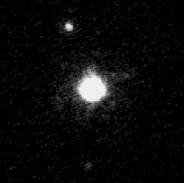 |
Dwarf planet Dwarf planet A dwarf planet, as defined by the International Astronomical Union , is a celestial body orbiting the Sun that is massive enough to be spherical as a result of its own gravity but has not cleared its neighboring region of planetesimals and is not a satellite... |
(Ortiz José Luis Ortiz Moreno José Luis Ortiz Moreno is an astronomer, and former Vicedirector of Technology at the Instituto de Astrofísica de Andalucía , Spain. He leads a team working on minor solar system objects at the Sierra Nevada Observatory in Granada, Spain.... , Aceituno Castro, Santos-Sanz) or (Brown Michael E. Brown Michael E. Brown has been a professor of planetary astronomy at the California Institute of Technology since 2003.... , Trujillo Chad Trujillo Chadwick A. "Chad" Trujillo is an astronomer and the co-discoverer of the dwarf planet Eris.Trujillo works with computer software and has examined the orbits of the numerous trans-Neptunian objects , which is the outer area of the solar system that he specialized in. In late August 2005, it was... , Rabinowitz David L. Rabinowitz David Lincoln Rabinowitz is a researcher at Yale University. He has built CCD cameras and software for the detection of near-Earth asteroids and Kuiper Belt Objects, and his research has helped reduce the assumed number of near-Earth asteroids by half, from 1,000-2,000 to 500-1,000 He has also... ) (see the Controversy over the discovery of Haumea Controversy over the discovery of Haumea was the first of all the dwarf planets to be discovered since Pluto in 1930. However, its naming and formal acceptance as a dwarf planet were delayed by several years due to controversy over who should receive credit for discovering it. A California Institute of Technology team headed by... ) |
|
| Date | Name | Temporary designation | Image | Permanent designation | Discoverer(s) and notes |
| i: December 12, 2004 |
(unnamed moon of Saturn) | S/2004 S 7 S/2004 S 7 S/2004 S 7 is a natural satellite of Saturn. Its discovery was announced by Scott S. Sheppard, David C. Jewitt, Jan Kleyna, and Brian G. Marsden on May 4, 2005 from observations taken between December 12, 2004 and March 8, 2005.... |
— | — | Sheppard Scott S. Sheppard Scott S. Sheppard is an astronomer in the Department of Terrestrial Magnetism at the Carnegie Institution for Science. Starting as a graduate student at the Institute for Astronomy at the University of Hawaii, he was credited with the discovery of many small moons of Jupiter, Saturn, Uranus, and... , Jewitt David C. Jewitt David C. Jewitt is a professor of astronomy formerly at the University of Hawaii Institute for Astronomy, now at UCLA. He was born in 1958 in England, and is a 1979 graduate of the University of London. Jewitt received an M.Sc. and a Ph.D. in astronomy at the California Institute of Technology in... , Kleyna Jan Kleyna Jan Kleyna is a postdoctoral astronomy researcher at the University of Hawaii Institute for Astronomy. His area of interest is galaxy dynamics, and he has worked to develop codes for the real-time detection of moving objects such as Jovian satellites. He has also co-discovered several of... , Marsden Brian G. Marsden Brian Geoffrey Marsden was a British astronomer born in Cambridge, England, and educated at The Perse School in Cambridge, New College, Oxford and Yale University. Dr... |
| Fornjot | S/2004 S 8 | — | Saturn XLII | ||
| Farbauti | S/2004 S 9 | — | Saturn XL | ||
| Aegir | S/2004 S 10 | — | Saturn XXXVI | ||
| Bebhionn | S/2004 S 11 | — | Saturn XXXVII | ||
| (unnamed moons of Saturn) | S/2004 S 12 S/2004 S 12 S/2004 S 12 is a natural satellite of Saturn. Its discovery was announced by Scott S. Sheppard, David C. Jewitt, Jan Kleyna, and Brian G. Marsden on May 4, 2005 from observations taken between December 12, 2004 and March 9, 2005.... |
— | — | ||
| S/2004 S 13 S/2004 S 13 S/2004 S 13 is a natural satellite of Saturn. Its discovery was announced by Scott S. Sheppard, David C. Jewitt, Jan Kleyna, and Brian G. Marsden on May 4, 2005 from observations taken between December 12, 2004 and March 9, 2005.... |
|||||
| Hati | S/2004 S 14 | — | Saturn XLIII | ||
| Bergelmir | S/2004 S 15 | Saturn XXXVIII | |||
| i: December 13, 2004 |
Fenrir | S/2004 S 16 | — | Saturn XLI | |
| (unnamed moon of Saturn) | S/2004 S 17 S/2004 S 17 S/2004 S 17 is a natural satellite of Saturn. Its discovery was announced by Scott S. Sheppard, David C. Jewitt, Jan Kleyna, and Brian G. Marsden on May 4, 2005 from observations taken between December 13, 2004 and March 5, 2005.... |
— | — | ||
| Bestla | S/2004 S 18 | — | Saturn XXXIX | ||
| i: May 1, 2005 |
Daphnis Daphnis (moon) Daphnis is an inner satellite of Saturn. It is also known as '; its provisional designation was '. Daphnis is about 8 kilometres in diameter, and orbits the planet in the Keeler Gap within the A ring.- Naming :... |
S/2005 S 1 | Saturn XXXV | Cassini–Huygens | |
| i: October 21, 2003 |
Eris Eris (dwarf planet) Eris, formal designation 136199 Eris, is the most massive known dwarf planet in the Solar System and the ninth most massive body known to orbit the Sun directly... |
 |
Dwarf planet Dwarf planet A dwarf planet, as defined by the International Astronomical Union , is a celestial body orbiting the Sun that is massive enough to be spherical as a result of its own gravity but has not cleared its neighboring region of planetesimals and is not a satellite... |
Brown Michael E. Brown Michael E. Brown has been a professor of planetary astronomy at the California Institute of Technology since 2003.... , Trujillo Chad Trujillo Chadwick A. "Chad" Trujillo is an astronomer and the co-discoverer of the dwarf planet Eris.Trujillo works with computer software and has examined the orbits of the numerous trans-Neptunian objects , which is the outer area of the solar system that he specialized in. In late August 2005, it was... , Rabinowitz David L. Rabinowitz David Lincoln Rabinowitz is a researcher at Yale University. He has built CCD cameras and software for the detection of near-Earth asteroids and Kuiper Belt Objects, and his research has helped reduce the assumed number of near-Earth asteroids by half, from 1,000-2,000 to 500-1,000 He has also... |
|
| o: January 26, 2005 |
Hiʻiaka Hi'iaka (moon) Hiiaka is the larger, outer moon of the dwarf planet Haumea.- Discovery and naming :Hiiaka was the first satellite discovered around Haumea. It is named after one of the daughters of Haumea, Hiiaka, the patron goddess of the Big Island of Hawaii, though at first it had gone by the nickname... |
S/2005 1 |  |
Haumea I | Brown, Trujillo, Rabinowitz |
| i: March 31, 2005 |
Makemake | — | Dwarf planet Dwarf planet A dwarf planet, as defined by the International Astronomical Union , is a celestial body orbiting the Sun that is massive enough to be spherical as a result of its own gravity but has not cleared its neighboring region of planetesimals and is not a satellite... |
Brown, Trujillo, Rabinowitz | |
| o: June 30, 2005 |
Namaka Namaka (moon) Namaka is the smaller, inner moon of the dwarf planet Haumea. It is named after Nāmaka, one of the daughters of Haumea, the goddess of the sea in Hawaiian mythology.- Discovery :Namaka was discovered on 30 June 2005 and announced on November 29, 2005... |
S/2005 2 |  |
Haumea II | Brown, Trujillo, Rabinowitz |
| i: September 10, 2005 |
Dysnomia Dysnomia (moon) - References :... |
S/2005 1 |  |
Eris I | Brown, van Dam, Bouchez, Le Mignant, Campbell, Chin, Conrad, Hartman, Johansson, Lafon, Rabinowitz, Stomski, Summers, Trujillo, Wizinowich |
| i: May 15, 2005 |
Nix Nix (moon) Nix is a natural satellite of Pluto. It was discovered along with Hydra in June 2005, and is to be visited along with Pluto by the New Horizons mission in July 2015.- Discovery :... |
S/2005 P 2 | 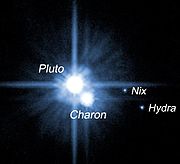 |
Pluto II | Weaver, Stern Alan Stern S. Alan Stern is an American planetary scientist. He is the principal investigator of the New Horizons mission to Pluto.... , Mutchler, Steffl, Buie Marc W. Buie Marc W. Buie is an astronomer at Lowell Observatory in Flagstaff, Arizona. He grew up in Baton Rouge, Louisiana and went on to get a B.S. in Physics from Louisiana State University in 1980. After that he switched fields and earned his Ph.D. in Planetary Science from the University of Arizona in... , Merline, |
| Hydra Hydra (moon) Hydra is the second outermost known natural satellite of Pluto. It was discovered along with Nix in June 2005, and is to be visited along with Pluto by the New Horizons mission in July 2015.- Discovery :... |
S/2005 P 1 | Pluto III | |||
| Date | Name | Temporary designation | Image | Permanent designation | Discoverer(s) and notes |
| i: December 12, 2004 |
Hyrrokkin | S/2004 S 19 | — | Saturn XLIV | Sheppard Scott S. Sheppard Scott S. Sheppard is an astronomer in the Department of Terrestrial Magnetism at the Carnegie Institution for Science. Starting as a graduate student at the Institute for Astronomy at the University of Hawaii, he was credited with the discovery of many small moons of Jupiter, Saturn, Uranus, and... , Jewitt David C. Jewitt David C. Jewitt is a professor of astronomy formerly at the University of Hawaii Institute for Astronomy, now at UCLA. He was born in 1958 in England, and is a 1979 graduate of the University of London. Jewitt received an M.Sc. and a Ph.D. in astronomy at the California Institute of Technology in... , Kleyna Jan Kleyna Jan Kleyna is a postdoctoral astronomy researcher at the University of Hawaii Institute for Astronomy. His area of interest is galaxy dynamics, and he has worked to develop codes for the real-time detection of moving objects such as Jovian satellites. He has also co-discovered several of... |
| i: January 4, 2006 |
(unnamed moon of Saturn) | S/2006 S 1 S/2006 S 1 S/2006 S 1 is a natural satellite of Saturn. Its discovery was announced by Scott S. Sheppard, David C. Jewitt, Jan Kleyna, and Brian G. Marsden on June 26, 2006 from observations taken between January 4 and April 30, 2006.... |
— | — | Sheppard, Jewitt, Kleyna |
| Kari | S/2006 S 2 | Saturn XLV | |||
| i: January 5, 2006 |
(unnamed moon of Saturn) | S/2006 S 3 S/2006 S 3 S/2006 S 3 is a natural satellite of Saturn. Its discovery was announced by Scott S. Sheppard, David C. Jewitt, Jan Kleyna, and Brian G. Marsden on June 26, 2006 from observations taken between January and April 2006.... |
— | — | |
| Greip | S/2006 S 4 | — | Saturn LI | ||
| Loge | S/2006 S 5 | — | Saturn XLVI | ||
| Jarnsaxa | S/2006 S 6 | — | Saturn L | ||
| Surtur | S/2006 S 7 | — | Saturn XLVIII | ||
| Skoll | S/2006 S 8 | — | Saturn XLVII | ||
| i: January 5, 2006 |
Tarqeq Tarqeq (moon) Tarqeq , also known as Saturn LII is a natural satellite of Saturn. Its discovery was announced by Scott S. Sheppard, David C. Jewitt, Jan Kleyna, and Brian G. Marsden on April 13, 2007, from observations taken between January 5, 2006, and March 22, 2007... |
S/2007 S 1 | — | Saturn LII | Sheppard Scott S. Sheppard Scott S. Sheppard is an astronomer in the Department of Terrestrial Magnetism at the Carnegie Institution for Science. Starting as a graduate student at the Institute for Astronomy at the University of Hawaii, he was credited with the discovery of many small moons of Jupiter, Saturn, Uranus, and... , Jewitt David C. Jewitt David C. Jewitt is a professor of astronomy formerly at the University of Hawaii Institute for Astronomy, now at UCLA. He was born in 1958 in England, and is a 1979 graduate of the University of London. Jewitt received an M.Sc. and a Ph.D. in astronomy at the California Institute of Technology in... , Kleyna Jan Kleyna Jan Kleyna is a postdoctoral astronomy researcher at the University of Hawaii Institute for Astronomy. His area of interest is galaxy dynamics, and he has worked to develop codes for the real-time detection of moving objects such as Jovian satellites. He has also co-discovered several of... |
| i: January 18, 2007 |
(unnamed moons of Saturn) | S/2007 S 2 S/2007 S 2 S/2007 S 2 is a natural satellite of Saturn. Its discovery was announced by Scott S. Sheppard, David C. Jewitt, Jan Kleyna, and Brian G. Marsden on May 1, 2007, from observations taken between January 18 and April 19, 2007.... |
— | — | Sheppard, Jewitt, Kleyna |
| S/2007 S 3 S/2007 S 3 S/2007 S 3 is a natural satellite of Saturn. Its discovery was announced by Scott S. Sheppard, David C. Jewitt, Jan Kleyna, and Brian G. Marsden on May 1, 2007 from observations taken between January 18 and April 19, 2007.... |
— | — | |||
| i: June, 2004 |
Anthe Anthe (moon) Anthe is a very small natural satellite of Saturn lying between the orbits of Mimas and Enceladus. It is also known as Saturn XLIX; its provisional designation was S/2007 S 4. It is named after one of the Alkyonides; the name means flowery. It is the sixtieth confirmed moon of Saturn.It was... |
S/2007 S 4 | 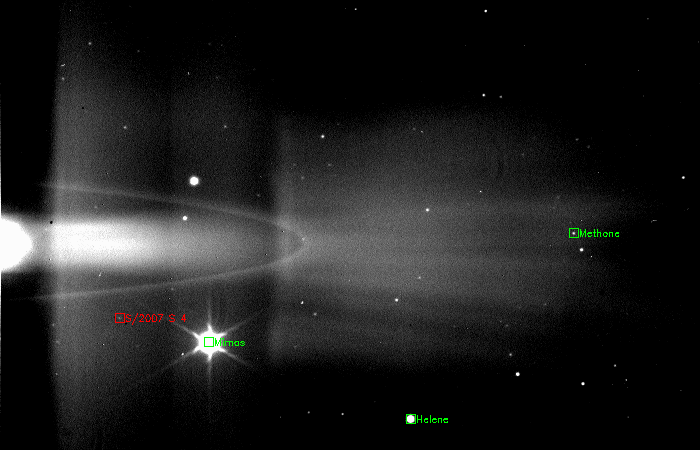 |
Saturn XLIX | Cassini–Huygens |
| i: August 15, 2008 |
Aegaeon | S/2008 S 1 | .jpg) |
Saturn LIII | Cassini–Huygens |
| i: July 26, 2009 |
(unnamed moon of Saturn) | S/2009 S 1 S/2009 S 1 S/2009 S 1 is a 'propeller moonlet' of Saturn orbiting at a distance of about , in the outer part of Saturn's B Ring, and with an approximate diameter of . It was discovered by the Cassini Imaging Team on July 26, 2009. The moon was noticed during the 2009 equinox event by an approximately long... |
— | Cassini–Huygens | |
| Date | Name | Temporary designation | Image | Permanent designation | Discoverer(s) and notes |
2010s
| 2010s | |||||
|---|---|---|---|---|---|
| Date | Name | Temporary designation | Image | Permanent designation | Discoverer(s) and notes |
i: September 7, 2010 p: June 1, 2011 |
(unnamed moons of Jupiter) | S/2010 J 1 S/2010 J 1 ' is a natural satellite of Jupiter. It was discovered by R. Jacobson, M. Brozovic, B. Gladman, and M. Alexandersen in 2010.... |
— | — | Jacobson, Brozovic, Gladman Brett J. Gladman Brett J. Gladman is a Canadian astronomer and a full professor at the University of British Columbia's Department of Physics and Astronomy in Vancouver, British Columbia. He holds the Canada Research Chair in Planetary Astronomy.-Career:... and Alexandersen |
i: September 7, 2010 p: June 1, 2011 |
S/2010 J 2 S/2010 J 2 ' is a natural satellite of Jupiter. It was discovered by Christian Veillet in 2010.... |
— | — | Veillet | |
i: June 28, 2011 p: July 20, 2011 |
(unnamed moon of Pluto) | S/2011 P 1 S/2011 P 1 S/2011 P 1 is a small natural satellite of Pluto whose existence was announced on July 20, 2011... |
— | Showalter | |
| Date | Name | Temporary designation | Image | Permanent designation | Discoverer(s) and notes |
See also
- Timeline of solar system astronomyTimeline of solar system astronomy-Antiquity:* 2nd millennium BC – earliest possible date for the composition of the Babylonian Venus tablet of Ammisaduqa, a 7th century BC copy of a list of observations of the motions of the planet Venus, and the oldest planetary table currently known....
- Timeline of Solar System explorationTimeline of solar system explorationThis is a timeline of Solar System exploration ordered by date of spacecraft launch. It includes:*All spacecraft that have left Earth orbit for the purposes of Solar System exploration , including lunar probes....
- Solar SystemSolar SystemThe Solar System consists of the Sun and the astronomical objects gravitationally bound in orbit around it, all of which formed from the collapse of a giant molecular cloud approximately 4.6 billion years ago. The vast majority of the system's mass is in the Sun...
External links
- City of Hudson's Natural Satellite Page
- Scott Sheppard's Giant Planet Satellite Page
- JPL Natural Satellite Discovery Data
- James L. HiltonJames L. HiltonJames Lindsay Hilton has been an astronomer at the United States Naval Observatory since 1986. In 1999 he published a new set of ephemerides for 15 of the largest asteroids for use in the Astronomical Almanac.-Education:...
, When did the asteroids become minor planets?

